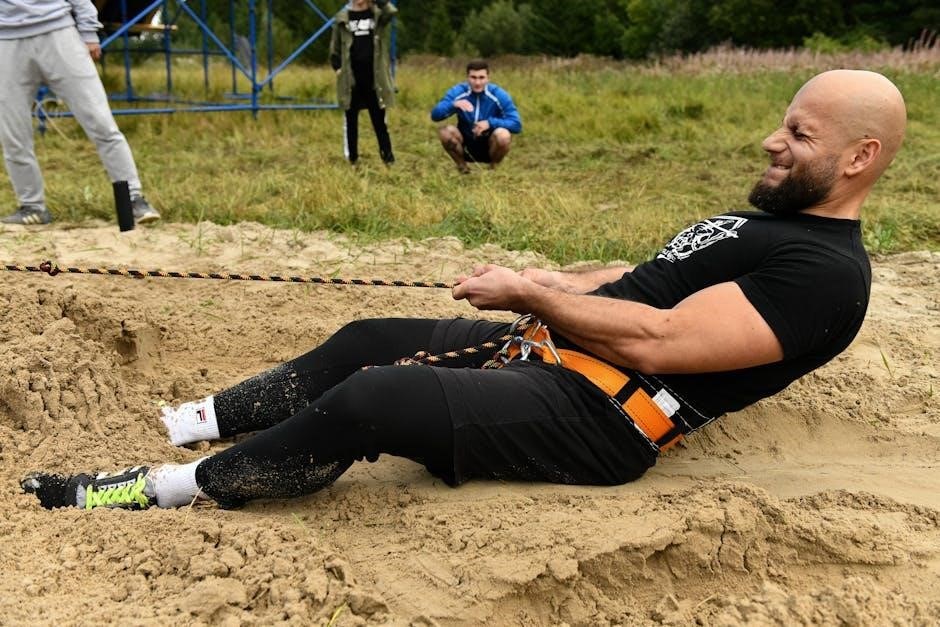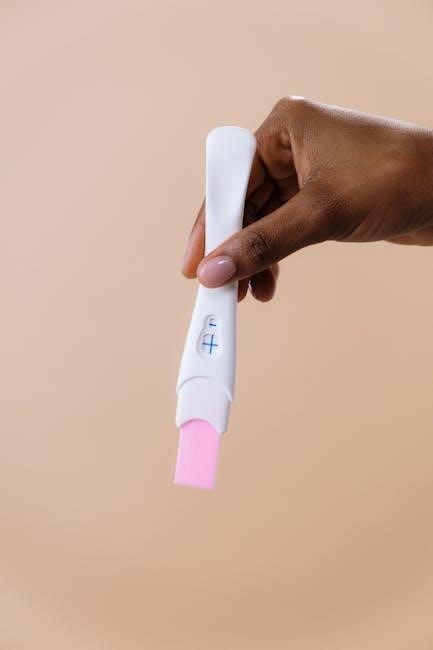The Timed Up and Go (TUG) test is a widely used assessment tool for evaluating functional mobility, balance, and fall risk in individuals.
It measures the time taken to stand, walk three meters, turn, and return to sitting, providing insights into mobility and overall physical function.
1.1. Definition and Purpose
The Timed Up and Go (TUG) test is a practical, performance-based assessment measuring an individual’s ability to perform basic mobility tasks. It involves standing from a chair, walking three meters, turning, and returning to sit. This test evaluates functional mobility, balance, and fall risk. Widely used in clinical and rehabilitation settings, the TUG test provides insight into physical function and is particularly useful for assessing older adults or those with mobility impairments. Its simplicity makes it a valuable tool for monitoring progress and predicting fall risk.
1.2. Importance in Clinical Assessments
The TUG test is a reliable and cost-effective tool in clinical settings for assessing functional mobility, balance, and fall risk. It provides valuable insights into an individual’s ability to perform daily activities safely. Widely used in rehabilitation and geriatric care, the test helps identify mobility impairments and monitor progress over time. Its simplicity and adaptability make it an essential component of comprehensive clinical evaluations, aiding healthcare professionals in developing targeted interventions to improve patient outcomes and reduce fall-related risks.

Equipment Needed for the TUG Test
A sturdy chair with armrests, a stopwatch, and a 3-meter marked distance are required. Optional tools include tape or cones for marking the course. Walking aids are allowed.

2.1. Chair and Measurement Tools
The TUG test requires a stable, armless chair placed against a wall for safety. A tape measure or masking tape is used to mark a 3-meter distance on the floor. Ensure the chair is positioned accurately, with its legs aligned to the starting point. The measurement tools help in setting the correct course length, while the chair provides a consistent starting and ending point for the test. These tools are essential for standardization and reliability.
2.2. Stopwatch and Marking Devices
A stopwatch is essential for accurately timing the TUG test, from the moment the patient stands until they sit back down. Marking devices, such as cones or tape, are used to clearly define the 3-meter walking distance. These tools ensure precise measurement of the test course, contributing to reliable and consistent results. Proper use of these devices is critical for maintaining the test’s validity and objectivity in assessing mobility and functional abilities. They are indispensable for standardized administration;
Test Procedure

The TUG test involves the patient standing from a chair, walking three meters, turning, and returning to sit, with the time recorded using a stopwatch.
3.1. Patient Preparation and Positioning
The patient is seated in a stable, armless chair with their back against the chair and feet flat on the floor. The chair is positioned against a wall for stability. The test area is cleared, and a 3-meter distance is marked on the floor. Patients are allowed to use walking aids if necessary. They are instructed to wear their regular footwear and to assume a comfortable position before starting the test.
3.2. Walking and Turning Instructions
The patient is instructed to walk at a comfortable, safe pace to a marked line 3 meters away, turn around, and return to sit in the chair. They may use an assistive device if needed. The movement should be natural, with no rushing. The test measures the time taken to complete the entire sequence, including standing, walking, turning, and sitting down. Clear verbal instructions are provided to ensure understanding and safety during the task. The patient’s gait, balance, and coordination are observed throughout the process.
3.3. Completion of the Test
The test concludes when the patient’s buttocks touch the chair seat after returning from the 3-meter walk. The stopwatch is stopped, and the time is recorded. Patients should use their usual walking aids if needed. The test assesses mobility, balance, and fall risk by observing gait, posture, and coordination. The measured time provides insight into functional abilities and mobility challenges. Verbal encouragement is avoided to ensure a natural and safe performance of the task. The test is simple, effective, and widely used in clinical settings.
Interpreting TUG Test Results

The TUG test measures the time to complete the task, with longer times indicating poorer mobility and higher fall risk. Normative values help assess functional abilities.

4.1. Time Measurement and Normative Values
The TUG test records the time taken to complete the task in seconds. Normative values vary by age and mobility levels, with younger adults typically completing it under 10 seconds. For older adults, times exceeding 12 seconds may indicate increased fall risk and mobility impairment. These benchmarks help clinicians assess functional abilities and monitor progress over time, ensuring accurate and reliable evaluations. Consistent measurement methods are essential for valid comparisons.
4.2. Assessing Mobility and Fall Risk
The TUG test effectively evaluates mobility by observing gait, balance, and overall functional ability. Prolonged completion times, especially over 12 seconds in older adults, indicate increased fall risk. Clinicians assess postural stability, stride length, and walking speed during the test. These observations provide valuable insights into a patient’s functional level and mobility challenges, aiding in early identification of fall risks and guiding targeted interventions to improve safety and independence.
Clinical Significance of the TUG Test
The TUG test is a reliable tool for assessing functional mobility and predicting fall risks, particularly in older adults and individuals with chronic conditions.
5.1. Relationship to Functional Mobility
The TUG test is a practical tool for assessing functional mobility, as it evaluates an individual’s ability to perform basic motor tasks like standing, walking, and turning.
It correlates strongly with gait speed, balance, and overall functional capacity, making it a valuable indicator of physical function in both clinical and rehabilitation settings.
5.2. Predicting Fall Risk in Older Adults
The TUG test is highly effective in predicting fall risk among older adults, with longer completion times indicating increased susceptibility.
Individuals taking 12 seconds or more to complete the test are considered at higher risk, making it a valuable tool for early identification and intervention in clinical settings.

Comparison with Other Mobility Assessments
The TUG test is often compared to the Six-Minute Walk Test (6MWT) and the 30-Second Chair Stand Test, each assessing different aspects of mobility and endurance.
6.1. Six-Minute Walk Test (6MWT)
The Six-Minute Walk Test (6MWT) measures endurance by assessing the distance walked in six minutes. Unlike the TUG test, it focuses on sustained walking ability rather than functional mobility tasks. The 6MWT is often used alongside the TUG test to provide a comprehensive view of a patient’s mobility, with the 6MWT emphasizing cardiovascular endurance and the TUG test highlighting functional movement and fall risk. Together, they offer complementary insights into a patient’s overall physical capabilities and recovery progress. Both are valuable tools in rehabilitation settings for assessing mobility and functional recovery. They are often used together to evaluate different aspects of patient mobility, with the 6MWT focusing on endurance and the TUG test on functional tasks. This combination provides a well-rounded assessment of a patient’s physical abilities and recovery progress in clinical settings. The 6MWT is particularly useful for patients with chronic conditions or those undergoing rehabilitation, as it measures their ability to sustain activity over time. In contrast, the TUG test is more practical for evaluating everyday mobility and fall risk. Both tests are simple, cost-effective, and widely used in clinical practice to monitor patient progress and plan appropriate interventions. They are often recommended for patients with mobility impairments to track improvements in their functional abilities. The 6MWT and TUG test are both essential tools for clinicians to assess mobility, endurance, and fall risk, providing valuable data for rehabilitation programs. By using both tests, clinicians can gain a comprehensive understanding of a patient’s mobility and design targeted interventions to enhance their functional abilities. The 6MWT and TUG test are both essential tools for clinicians to assess mobility, endurance, and fall risk, providing valuable data for rehabilitation programs. By using both tests, clinicians can gain a comprehensive understanding of a patient’s mobility and design targeted interventions to enhance their functional abilities. The 6MWT and TUG test are both essential tools for clinicians to assess mobility, endurance, and fall risk, providing valuable data for rehabilitation programs. By using both tests, clinicians can gain a comprehensive understanding of a patient’s mobility and design targeted interventions to enhance their functional abilities. The 6MWT and TUG test are both essential tools for clinicians to assess mobility, endurance, and fall risk, providing valuable data for rehabilitation programs. By using both tests, clinicians can gain a comprehensive understanding of a patient’s mobility and design targeted interventions to enhance their functional abilities. The 6MWT and TUG test are both essential tools for clinicians to assess mobility, endurance, and fall risk, providing valuable data for rehabilitation programs. By using both tests, clinicians can gain a comprehensive understanding of a patient’s mobility and design targeted interventions to enhance their functional abilities. The 6MWT and TUG test are both essential tools for clinicians to assess mobility, endurance, and fall risk, providing valuable data for rehabilitation programs. By using both tests, clinicians can gain a comprehensive understanding of a patient’s mobility and design targeted interventions to enhance their functional abilities. The 6MWT and TUG test are both essential tools for clinicians to assess mobility, endurance, and fall risk, providing valuable data for rehabilitation programs. By using both tests, clinicians can gain a comprehensive understanding of a patient’s mobility and design targeted interventions to enhance their functional abilities. The 6MWT and TUG test are both essential tools for clinicians to assess mobility, endurance, and fall risk, providing valuable data for rehabilitation programs. By using both tests, clinicians can gain a comprehensive understanding of a patient’s mobility and design targeted interventions to enhance their functional abilities. The 6MWT and TUG test are both essential tools for clinicians to assess mobility, endurance, and fall risk, providing valuable data for rehabilitation programs. By using both tests, clinicians can gain a comprehensive understanding of a patient’s mobility and design targeted interventions to enhance their functional abilities. The 6MWT and TUG test are both essential tools for clinicians to assess mobility, endurance, and fall risk, providing valuable data for rehabilitation programs. By using both tests, clinicians can gain a comprehensive understanding of a patient’s mobility and design targeted interventions to enhance their functional abilities. The 6MWT and TUG test are both essential tools for clinicians to assess mobility, endurance, and fall risk, providing valuable data for rehabilitation programs. By using both tests, clinicians can gain a comprehensive understanding of a patient’s mobility and design targeted interventions to enhance their functional abilities. The 6MWT and TUG test are both essential tools for clinicians to assess mobility, endurance, and fall risk, providing valuable data for rehabilitation programs. By using both tests, clinicians can gain a comprehensive understanding of a patient’s mobility and design targeted interventions to enhance their functional abilities. The 6MWT and TUG test are both essential tools for clinicians to assess mobility, endurance, and fall risk, providing valuable data for rehabilitation programs. By using both tests, clinicians can gain a comprehensive understanding of a patient’s mobility and design targeted interventions to enhance their functional abilities. The 6MWT and TUG test are both essential tools for clinicians to assess mobility, endurance, and fall risk, providing valuable data for rehabilitation programs. By using both tests, clinicians can gain a comprehensive understanding of a patient’s mobility and design targeted interventions to enhance their functional abilities. The 6MWT and TUG test are both essential tools for clinicians to assess mobility, endurance, and fall risk, providing valuable data for rehabilitation programs. By using both tests, clinicians can gain a comprehensive understanding of a patient’s mobility and design targeted interventions to enhance their functional abilities. The 6MWT and TUG test are both essential tools for clinicians to assess mobility, endurance, and fall risk, providing valuable data for rehabilitation programs. By using both tests, clinicians can gain a comprehensive understanding of a patient’s mobility and design targeted interventions to enhance their functional abilities. The 6MWT and TUG test are both essential tools for clinicians to assess mobility, endurance, and fall risk, providing valuable data for rehabilitation programs. By using both tests, clinicians can gain a comprehensive understanding of a patient’s mobility and design targeted interventions to enhance their functional abilities. The 6MWT and TUG test are both essential tools for clinicians to assess mobility, endurance, and fall risk, providing valuable data for rehabilitation programs. By using both tests, clinicians can gain a comprehensive understanding of a patient’s mobility and design targeted interventions to enhance their functional abilities. The 6MWT and TUG test are both essential tools for clinicians to assess mobility, endurance, and fall risk, providing valuable data for rehabilitation programs. By using both tests, clinicians can gain a comprehensive understanding of a patient’s mobility and design targeted interventions to enhance their functional abilities. The 6MWT and TUG test are both essential tools for clinicians to assess mobility, endurance, and fall risk, providing valuable data for rehabilitation programs. By using both tests, clinicians can gain a comprehensive understanding of a patient’s mobility and design targeted interventions to enhance their functional abilities. The 6MWT and TUG test are both essential tools for clinicians to assess mobility, endurance, and fall risk, providing valuable data for rehabilitation programs. By using both tests, clinicians can gain a comprehensive understanding of a patient’s mobility and design targeted interventions to enhance their functional abilities. The 6MWT and TUG test are both essential tools for clinicians to assess mobility, endurance, and fall risk, providing valuable data for rehabilitation programs. By using both tests, clinicians can gain a comprehensive understanding of a patient’s mobility and design targeted interventions to enhance their functional abilities. The 6MWT and TUG test are both essential tools for clinicians to assess mobility, endurance, and fall risk, providing valuable data for rehabilitation programs. By using both tests, clinicians can gain a comprehensive understanding of a patient’s mobility and design targeted interventions to enhance their functional abilities. The 6MWT and TUG test are both essential tools for clinicians to assess mobility, endurance, and fall risk, providing valuable data for rehabilitation programs. By using both tests, clinicians can gain a comprehensive understanding of a patient’s mobility and design targeted interventions to enhance their functional abilities. The 6MWT and TUG test are both essential tools for clinicians to assess mobility, endurance, and fall risk, providing valuable data for rehabilitation programs. By using both tests, clinicians can gain a comprehensive understanding of a patient’s mobility and design targeted interventions to enhance their functional abilities. The 6MWT and TUG test are both essential tools for clinicians to assess mobility, endurance, and fall risk, providing valuable data for rehabilitation programs. By using both tests, clinicians can gain a comprehensive understanding of a patient’s mobility and design targeted interventions to enhance their functional abilities. The 6MWT and TUG test are both essential tools for clinicians to assess mobility, endurance, and fall risk, providing valuable data for rehabilitation programs. By using both tests, clinicians can gain a comprehensive understanding of a patient’s mobility and design targeted interventions to enhance their functional abilities. The 6MWT and TUG test are both essential tools for clinicians to assess mobility, endurance, and fall risk, providing valuable
6.2. 30-Second Chair Stand Test
The 30-Second Chair Stand Test (30-Second CST) measures lower limb strength and endurance by counting how many times a patient can stand and sit in 30 seconds. Unlike the TUG test, it focuses solely on the ability to rise from and return to a seated position, reflecting functional strength and mobility. This test is often used alongside the TUG test to assess different aspects of physical function, providing complementary insights into a patient’s overall mobility and fall risk. It is particularly useful for evaluating older adults and individuals with mobility impairments, as it correlates with functional independence and fall risk. The 30-Second CST is simple, requires minimal equipment, and is widely used in clinical and rehabilitation settings to monitor progress and plan interventions. Together with the TUG test, it offers a comprehensive assessment of functional mobility, helping clinicians identify areas for targeted rehabilitation. The 30-Second CST is a practical tool for evaluating strength, endurance, and functional ability, making it a valuable addition to mobility assessments in various clinical populations. By combining it with the TUG test, clinicians can gain a more complete understanding of a patient’s physical capabilities and design effective rehabilitation strategies to improve mobility and reduce fall risk. The 30-Second CST is particularly effective for monitoring changes over time and assessing the impact of interventions on functional strength and endurance. Its simplicity and effectiveness make it a popular choice in rehabilitation settings, where quick and reliable assessments are essential for patient care. The 30-Second CST and TUG test together provide a robust framework for evaluating and enhancing functional mobility in diverse patient populations. By using both tests, clinicians can address a wide range of mobility challenges and develop tailored rehabilitation plans to improve patient outcomes. The 30-Second CST is a valuable tool for assessing functional strength and endurance, complementing the TUG test’s focus on dynamic mobility. Together, they offer a comprehensive approach to evaluating and enhancing physical function in clinical settings. The 30-Second CST is particularly useful for identifying individuals at risk of functional decline and falls, making it an essential component of mobility assessments in geriatric and rehabilitation care. By incorporating both the 30-Second CST and the TUG test, clinicians can gather a detailed understanding of a patient’s mobility and design targeted interventions to improve strength, endurance, and overall functional ability. This dual approach ensures a more accurate and effective assessment of mobility, enabling better patient outcomes and improved quality of life. The 30-Second CST and TUG test are both essential tools for clinicians to assess mobility, strength, and fall risk, providing valuable data for rehabilitation programs. By using both tests, clinicians can gain a comprehensive understanding of a patient’s mobility and design targeted interventions to enhance their functional abilities. The 30-Second CST and TUG test are both essential tools for clinicians to assess mobility, strength, and fall risk, providing valuable data for rehabilitation programs. By using both tests, clinicians can gain a comprehensive understanding of a patient’s mobility and design targeted interventions to enhance their functional abilities. The 30-Second CST and TUG test are both essential tools for clinicians to assess mobility, strength, and fall risk, providing valuable data for rehabilitation programs. By using both tests, clinicians can gain a comprehensive understanding of a patient’s mobility and design targeted interventions to enhance their functional abilities. The 30-Second CST and TUG test are both essential tools for clinicians to assess mobility, strength, and fall risk, providing valuable data for rehabilitation programs. By using both tests, clinicians can gain a comprehensive understanding of a patient’s mobility and design targeted interventions to enhance their functional abilities. The 30-Second CST and TUG test are both essential tools for clinicians to assess mobility, strength, and fall risk, providing valuable data for rehabilitation programs. By using both tests, clinicians can gain a comprehensive understanding of a patient’s mobility and design targeted interventions to enhance their functional abilities. The 30-Second CST and TUG test are both essential tools for clinicians to assess mobility, strength, and fall risk, providing valuable data for rehabilitation programs. By using both tests, clinicians can gain a comprehensive understanding of a patient’s mobility and design targeted interventions to enhance their functional abilities. The 30-Second CST and TUG test are both essential tools for clinicians to assess mobility, strength, and fall risk, providing valuable data for rehabilitation programs. By using both tests, clinicians can gain a comprehensive understanding of a patient’s mobility and design targeted interventions to enhance their functional abilities. The 30-Second CST and TUG test are both essential tools for clinicians to assess mobility, strength, and fall risk, providing valuable data for rehabilitation programs. By using both tests, clinicians can gain a comprehensive understanding of a patient’s mobility and design targeted interventions to enhance their functional abilities. The 30-Second CST and TUG test are both essential tools for clinicians to assess mobility, strength, and fall risk, providing valuable data for rehabilitation programs. By using both tests, clinicians can gain a comprehensive understanding of a patient’s mobility and design targeted interventions to enhance their functional abilities. The 30-Second CST and TUG test are both essential tools for clinicians to assess mobility, strength, and fall risk, providing valuable data for rehabilitation programs. By using both tests, clinicians can gain a comprehensive understanding of a patient’s mobility and design targeted interventions to enhance their functional abilities. The 30-Second CST and TUG test are both essential tools for clinicians to assess mobility, strength, and fall risk, providing valuable data for rehabilitation programs. By using both tests, clinicians can gain a comprehensive understanding of a patient’s mobility and design targeted interventions to enhance their functional abilities. The 30-Second CST and TUG test are both essential tools for clinicians to assess mobility, strength, and fall risk, providing valuable data for rehabilitation programs. By using both tests, clinicians can gain a comprehensive understanding of a patient’s mobility and design targeted interventions to enhance their functional abilities. The 30-Second CST and TUG test are both essential tools for clinicians to assess mobility, strength, and fall risk, providing valuable data for rehabilitation programs. By using both tests, clinicians can gain a comprehensive understanding of a patient’s mobility and design targeted interventions to enhance their functional abilities. The 30-Second CST and TUG test are both essential tools for clinicians to assess mobility, strength, and fall risk, providing valuable data for rehabilitation programs. By using both tests, clinicians can gain a comprehensive understanding of a patient’s mobility and design targeted interventions to enhance their functional abilities. The 30-Second CST and TUG test are both essential tools for clinicians to assess mobility, strength, and fall risk, providing valuable data for rehabilitation programs. By using both tests, clinicians can gain a comprehensive understanding of a patient’s mobility and design targeted interventions to enhance their functional abilities. The 30-Second CST and TUG test are both essential tools for clinicians to assess mobility, strength, and fall risk, providing valuable data for rehabilitation programs. By using both tests, clinicians can gain a comprehensive understanding of a patient’s mobility and design targeted interventions to enhance their functional abilities. The 30-Second CST and TUG test are both essential tools for clinicians to assess mobility, strength, and fall risk, providing valuable data for rehabilitation programs. By using both tests, clinicians can gain a comprehensive understanding of a patient’s mobility and design targeted interventions to enhance their functional abilities. The 30-Second CST and TUG test are both essential tools for clinicians to assess mobility, strength, and fall risk, providing valuable data for rehabilitation programs. By using both tests, clinicians can gain a comprehensive understanding of a patient’s mobility and design








































































